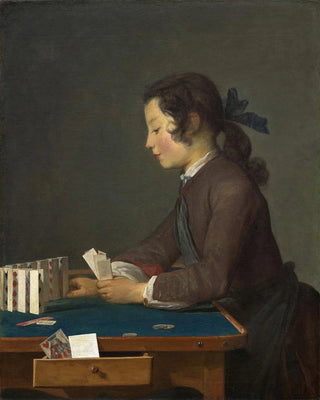Art print | The House of Cards - Jean Siméon Chardin


View from behind

Frame (optional)
In the world of art, some works transcend their era to become timeless witnesses to the human condition. "The House of Cards" by Jean Siméon Chardin is one of those creations that, through its apparent simplicity, provokes deep reflection. This painting, depicting a scene from everyday life, invites us to contemplate the fragility of human constructions, both material and symbolic. Through this masterpiece, Chardin immerses us in a universe where the delicacy of the cards evokes both childhood innocence and the precariousness of existence. It is a work that, beyond its beauty, reminds us of the need to grasp the ephemeral.
Style and uniqueness of the work
Chardin's style is distinguished by its striking realism and meticulous attention to detail. In "The House of Cards," the soft light illuminating the scene highlights the texture of the cards, creating a play of shadows and lights that enhances the dramatic tension of the piece. The colors, both vivid and subtle, contribute to an atmosphere of calm and serenity, contrasting with the fragility of the paper structure. Chardin, a true master of the genre, manages to capture the very essence of the moment, transforming a playful activity into a profound reflection on the nature of life. Each card, carefully stacked, becomes a symbol of hope and ambition, but also of the inherent vulnerability of every human creation.
The artist and his influence
Jean Siméon Chardin, an emblematic figure of the 18th century, mastered to impose his unique style within the rococo movement. His ability to paint scenes of everyday life with such psychological depth influenced many artists. Chardin does not merely depict objects or mundane scenes; he endows them with an emotional dimension, inviting the viewer to question human relationships and the values of his time. His approach to the genre of still life, or nature morte, paved the way for a new appreciation of simplicity, thereby redefining the aesthetic standards of his era. Through "

Matte finish

View from behind

Frame (optional)
In the world of art, some works transcend their era to become timeless witnesses to the human condition. "The House of Cards" by Jean Siméon Chardin is one of those creations that, through its apparent simplicity, provokes deep reflection. This painting, depicting a scene from everyday life, invites us to contemplate the fragility of human constructions, both material and symbolic. Through this masterpiece, Chardin immerses us in a universe where the delicacy of the cards evokes both childhood innocence and the precariousness of existence. It is a work that, beyond its beauty, reminds us of the need to grasp the ephemeral.
Style and uniqueness of the work
Chardin's style is distinguished by its striking realism and meticulous attention to detail. In "The House of Cards," the soft light illuminating the scene highlights the texture of the cards, creating a play of shadows and lights that enhances the dramatic tension of the piece. The colors, both vivid and subtle, contribute to an atmosphere of calm and serenity, contrasting with the fragility of the paper structure. Chardin, a true master of the genre, manages to capture the very essence of the moment, transforming a playful activity into a profound reflection on the nature of life. Each card, carefully stacked, becomes a symbol of hope and ambition, but also of the inherent vulnerability of every human creation.
The artist and his influence
Jean Siméon Chardin, an emblematic figure of the 18th century, mastered to impose his unique style within the rococo movement. His ability to paint scenes of everyday life with such psychological depth influenced many artists. Chardin does not merely depict objects or mundane scenes; he endows them with an emotional dimension, inviting the viewer to question human relationships and the values of his time. His approach to the genre of still life, or nature morte, paved the way for a new appreciation of simplicity, thereby redefining the aesthetic standards of his era. Through "






